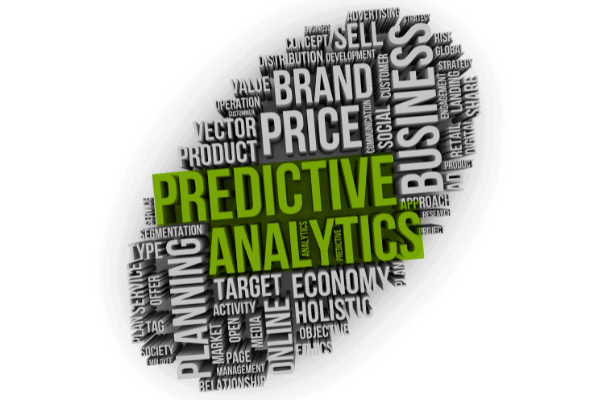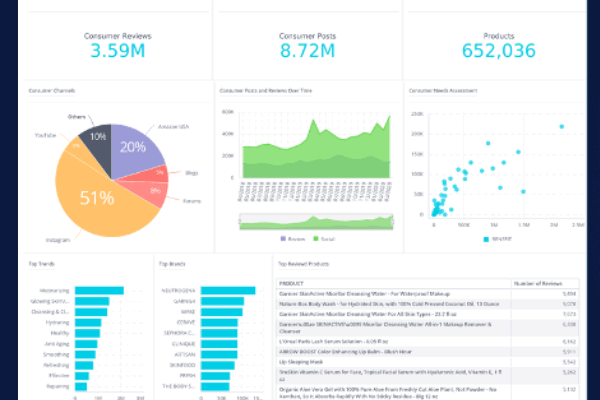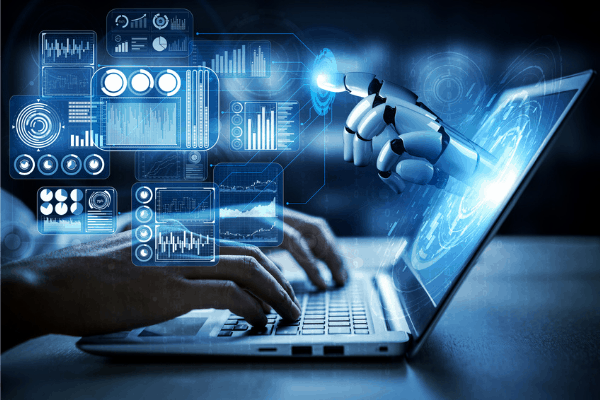
Predictive analytics refers to the process of generating predictions or actionable insights from raw data. The internet contains around 40 billion trillion bytes of data, 40x more than the number of stars in the known universe. Predictive analytics enables companies to harness this data, understand which parts are connected, and what is dependent on what. This could identify companies and technologies that are relevant M&A targets, for example, or uncover unaddressed consumer needs.
The data itself is drawn from an array of sources – such as social media, public records, patent filings, product ratings, company announcements, sales data, product reviews, key opinion leaders and more. Relevant parts are collected into a store known as a data lake. This data contains all sorts of useful information for your business, such as industry trends, opportunities, and competitive analysis. The problem is that it is unorganized and unstructured, like many patterns in the sky.
In order to generate predictive insights from this data, analysts need to organize it in a way that allows them to extract value or useful insights about future trends or outcomes. This requires massive resources – such as powerful AI capabilities – that only a few possess. It can be challenging enough to extract actionable insights from internal data or other structured sources. Adding external, unstructured data into the mix is exponentially more complicated.
So there are two pieces involved in predictive analytics: First, having a human or machine look at the data to get it in the right form and shape, so you can generate insights from it. Second, using software to extract those connectivities and impact within the data.
Let’s take a deeper look at each of these steps and how they look in practice.
Two Models for Predictive Analytics: Human and Machine
The predictive analytics journey begins with a question. Brands need to define their goals and ask: “What do we want to know about the future based on the past?” or “What trends do we want to understand and predict?” Often, it’s looking for a gap in the market, where many people are interested in an ingredient or benefit, but not too many products offer it. Once the goal is clear, data collection can begin.
During this initial stage, data is drawn from thousands of external sources — including social media, abstracts, registries, directories, public records, knowledge centers, research papers, and digital archives. Key opinion leaders are a useful source of data, because they often can tell us things that may indicate a trend. Depending on your enterprise, where you collect appropriate data will vary.
Data often arrives unstructured, so it must be processed and prepared. There are two types of models for how to handle this unstructured data. The first, we can say, uses the brains of data scientists. There are very common things a data scientist might look at. They could look at, for example, the number of reviews that talk about some feature of a product, and the number of products that claim this feature.
If there are a very few number of products with that feature, and people talk about the feature in a positive way, that could indicate an unmet need in the market. This is a classic example of where there’s a lot of interest from the public, but very few companies are talking about it.
There’s another type of model – the machine learning side. Let’s assume we follow product sales in the world, and we break down the ingredients of those products, and we suddenly find, say, a lot of growth in products containing Vitamin C. Machine-learning systems can surface something like that and connect it to current trends – for example, the coronavirus – automatically. Nobody has to know that Vitamin C is in the data, but the system itself is able to detect a change in product sales that include Vitamin C.
This automated process opens significant opportunities, as it can uncover patterns in a much faster fashion than a manual scan. It also frees analysts from the laborious task of processing data, but it relies on having structured data to begin with.
The Challenge of Unstructured Data
A key complexity with predictive analytics is understanding the structure behind all those dispersed data points that are created by different people in the world.
Most of the data that Skai uses is entered by a human – a description of an item on a website, a product review, or a social media post that someone leaves somewhere. The challenge is the data is usually not in any shape that allows you to run predictive analytics. It’s not being entered in a specific form, but sometimes is in different languages, different structures, sometimes completely unstructured. Sometimes it’s being entered in the form of very nice graphics, pictures, and various styles.
Another significant technological challenge e-commerce retailers and brands face is product duplications. Sellers often list a product under different names, images, or descriptions, or mistype product code. This can result in multiple listings for what is essentially the same product, making it a challenge to understand market penetration and performance. Skai’s unique product clustering solution solves this issue by identifying the same products across the various e-commerce listings for a unified view of the product. Product clustering is an essential step before applying predictive analytics to e-commerce data to achieve accurate foresight.
The goal here is to be able to automatically gather all those data points together, then run them through a pipeline that automatically extracts their meaning. This enables Skai to automate the process of understanding why things happened, what is going on, or general understanding from the data, without a human having to be involved at each step.
Structuring Data Through AI
It’s a difficult process to clean and prepare raw data to a state where it’s ready to be analyzed. If somebody mentions the word ‘apple,’ is it the company? Is it a fruit? Are they describing it in a positive way?
To understand the structure of raw data – for example, a sentence from an industry expert’s product review – Skai applies proprietary techniques using Natural Language Processing (NLP) and machine learning. Its patented NLP algorithm breaks down a sentence into a simplified representation that can be readily analyzed. This allows Skai to store the key parts of a sentence, such as verbs, the who or what, the when or where, and the how, in a consistent way.
The algorithm further structures sentences by examining values such as sentiments – whether an opinion is positive or negative – and taxonomy, such as benefits (e.g. affordability) or ingredients (e.g. milk). Skai can then run machine learning algorithms to understand and extract the important insights out of it.
How We Generate Richer, More Accurate Predictions
The power of Skai’s proprietary algorithm is not that it can match sentences word-for-word, but that it can understand the structure of sentences, and the meaning of each part in the context of the entire sentence. Its unique technology can further classify and connect different data types, like sales data, key opinion, leaders, and clinical trials. When this structured data is combined with actual historical sales data through Skai’s integration with Nielsen, the algorithm can generate quantitative predictions that guide strategic decisions.
Skai can use similar techniques to identify trends and develop qualitative predictions (such as growth in social media discussion) around any type of product feature. Its ability to input classified data from multiple sources and connect them together allows Skai to generate richer, more accurate predictions than if it were only relying on a single source, or multiple disconnected sources.
Who Uses Predictive Analytics?
Predictive analytics empowers companies across the spectrum, from beauty to food and beverage to consumer goods. The way each industry applies predictive analytics depends on its market, its goals, its regulatory environment, and its competitive landscape.
Let’s take a look at how specific segments are leveraging predictive analytics techniques to unveil new opportunities and forecast the future.
Predictive Analytics in Food and Beverage – Leading food and beverage brands use predictive analytics to uncover emerging market trends, measure consumer sentiments, and predict future interests. It gives a holistic view of your market’s present and future landscape, and allows you to focus on strategic development.
From allergen-free products to CBD, see our predictions for food and beverage trends in 2020.
Predictive Analytics in Retail – Retail brands can use predictive analytics to optimize product portfolio health, accelerate new product development, propel breakthrough innovations, and retain valuable customers.
What Are the Benefits of Predictive Analytics?
No matter the industry, the benefits of predictive analytics are clear. Data-derived insights can help organizations better allocate resources, reduce risks, and improve the bottom line. Below, we’ve outlined three ways businesses can benefit from using predictive analytics.
-
Transform Data into Business Growth Opportunities – Predictive analytics can help companies turn trillions of external data points into deep insights. Relevant market data sets organizations up for growth by allowing them to forecast for inventory and consumer trends, determine production rates, improve cost savings, and maximize profit margins.
-
Track Customer Behaviors and Attitudes – Predictive analytics can help organizations form a clearer picture of who their customers are and what they want. With this information, brands can provide unique product offerings that meet their needs and, in turn, increase sales.
-
Gain Advantage over Competitors – Predictive analytics provides a clear look into the competitive landscape. Data can show potential gaps in the market, leading brands to jump on opportunities and provide a product or service that no other company can.
Why Choose the Skai Platform?
Skai helps businesses effectively employ external data for decision making. We offer the most accessible, usable, and relevant data from multiple external sources to help brands see the big picture.
The unique thing about Skai is we can provide analytics in an automated way. We support the whole story – from collecting the data to generating the insights. We base our analytics on data from numerous sources, based on our subject matter experts’ knowledge of the industries we serve. We take that unstructured data, clean and structure it automatically, run analytics and generate forecasts and predictions you can use.
With Skai , your organization will spend less time locating, processing, and interpreting data and more time incorporating real-time insights into your business interactions and plans.
To ensure you have access to the most helpful industry insights, we center our approach around:
-
Strong data foundation – Most data platforms are limited to a single data source or data type. We integrate a wide range of external data sources through our platform to provide you with the most pertinent information.
-
Granular insights & predictions – Our patented NLP engines and proprietary taxonomies extract context from disparate data to capture consumer and market trends that would otherwise be missed.
-
Configurability – Our platform is configurable to meet your desired needs. Depending on your market, you can choose your data sources, modify taxonomies, and create dashboards that suit your business goals.
-
Analytic apps and integrations – Our data and analytics seamlessly fit into your business intelligence platform, or use our powerful set of analytic apps.
————————————–
*This blog post originally appeared on Signals-Analytics.com. Kenshoo acquired Signals-Analytics in December 2020. Read the press release.





